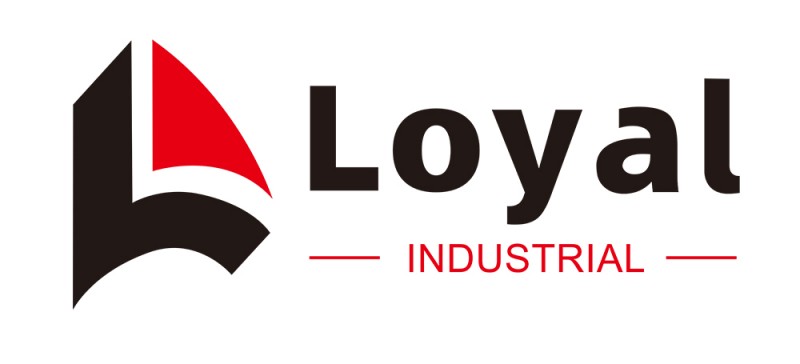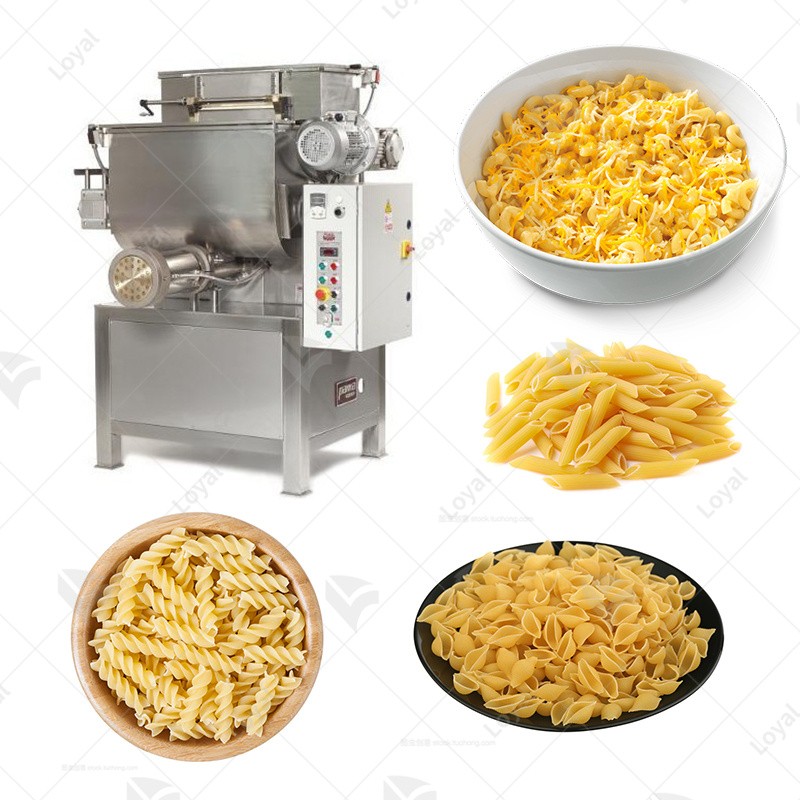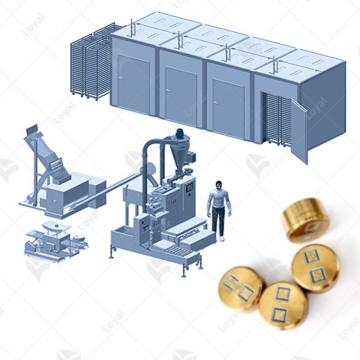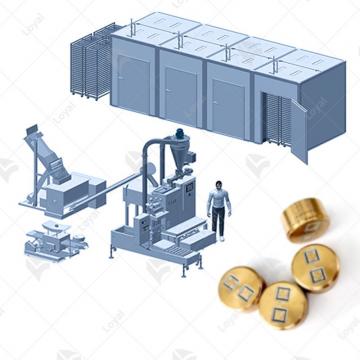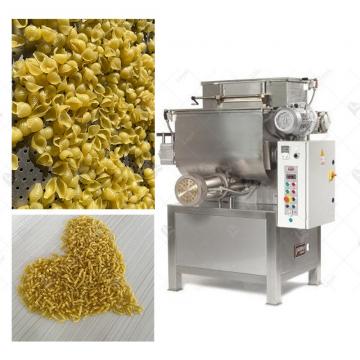Enhanced Pasta Production: Full Automation and Manufacturing Shortcuts for Optimal Efficiency
Enhanced Pasta Production: Full Automation and Manufacturing Shortcuts for Optimal Efficiency
Combined pasta machine has undergone a significant transformation with the integration of full automation and manufacturing shortcuts. In this era of advanced food machinery, the combination of cutting-edge technology and strategic manufacturing approaches has revolutionized the efficiency and precision of pasta manufacturing processes.Shandong Loyal Industrial Co., Ltd. has incorporated advanced technologies from FAVA and UTF in the production of its macaroni.
The significance of automation in manufacturing cannot be overstated. As we delve into the enhanced pasta production methods, it becomes evident how automation, coupled with manufacturing shortcuts, contributes to optimal efficiency in the industry.
Evolution of Pasta Manufacturing
Traditionally, pasta manufacturing relied on manual methods, posing various challenges such as time consumption and inconsistent quality. The evolution of pasta manufacturing took a pivotal turn with the introduction of automation in the industry. This transition not only addressed the challenges but also set the stage for a new era of efficiency and innovation in pasta production.
The Role of Full Automation
Full automation plays a crucial role in enhancing pasta production. The benefits are manifold, including increased efficiency and precision in every stage of the manufacturing process. Automation ensures a streamlined workflow, from ingredient handling to packaging, resulting in a more consistent and high-quality pasta product.
Manufacturing Shortcuts in Pasta Production
Manufacturing shortcuts are integral to optimizing the pasta production process. Defined as strategic and efficient methods, these shortcuts significantly impact the overall efficiency of the manufacturing process. Their implementation involves innovative approaches that streamline production without compromising the quality of the final product.
In the context of pasta production, these shortcuts are carefully integrated into the manufacturing process to expedite production without sacrificing the authenticity and taste that consumers expect from renowned pasta brands like Jovial, DeLallo, Faella, Pastificio Di Martino, and Rao's Homemade.
Technological Advancements
Cutting-edge technologies have become synonymous with automated pasta production. From intelligent machinery to data-driven systems, technological advancements have played a pivotal role in elevating the efficiency and output of pasta manufacturing. The integration of smart systems further enhances the precision and control over the production process.
Case Studies
Examining successful implementations of full automation and manufacturing shortcuts provides valuable insights. Real-world examples showcase how industry leaders have embraced innovation to achieve unprecedented levels of efficiency in pasta production. These case studies serve as inspiration for others seeking to optimize their manufacturing processes.

Future Trends
The future of pasta manufacturing holds exciting possibilities with emerging technologies. From robotic systems to sustainable practices, the industry is poised for continuous innovation. Exploring these trends offers a glimpse into the potential innovations that could further enhance efficiency in pasta production.
Challenges and Solutions
While automation and manufacturing shortcuts bring about transformative changes, challenges are inevitable. Addressing these challenges in automated pasta production requires strategic approaches. This section delves into the potential obstacles and provides insights into overcoming limitations associated with manufacturing shortcuts.
Conclusion
In conclusion, the integration of full automation and manufacturing shortcuts marks a milestone in the pasta manufacturing industry. The benefits of increased efficiency, precision, and consistency underscore the positive impact of these advancements. As we recap the advantages, the future prospects for the pasta manufacturing industry appear promising, setting the stage for continued innovation and growth.

FAQs: Common Questions about Manufacturing Shortcuts
Q1: What are manufacturing shortcuts in the context of pasta production?
A1: Manufacturing shortcuts refer to strategic and efficient methods integrated into the pasta production process to streamline and expedite various stages. These shortcuts are designed to enhance efficiency without compromising the quality of the final product.
Q2: How do manufacturing shortcuts contribute to optimal efficiency?
A2: Manufacturing shortcuts play a pivotal role in optimizing efficiency by introducing innovative approaches to streamline production. These methods are carefully implemented to expedite processes without sacrificing the authenticity and quality of the pasta product.
Q3: Can you provide examples of manufacturing shortcuts in pasta production?
A3: Certainly. Examples of manufacturing shortcuts include optimized ingredient handling, efficient mixing processes, and innovative packaging solutions. These strategic approaches aim to reduce production time and costs while maintaining the high standards expected from renowned pasta brands.
Q4: Are manufacturing shortcuts applicable to all types of pasta?
A4: Yes, manufacturing shortcuts can be tailored to various types of pasta. Whether it's long noodles, short shapes, or filled pasta, strategic shortcuts can be implemented to enhance the efficiency of production processes while meeting specific quality standards.
Q5: How do manufacturers ensure the quality of pasta when implementing shortcuts?
A5: Manufacturers ensure quality by carefully selecting and testing manufacturing shortcuts that align with their quality standards. Advanced technology and precision control systems are often employed to monitor and maintain the desired quality throughout the production process.
Q6: Do manufacturing shortcuts impact the taste and texture of the final pasta product?
A6: When implemented thoughtfully, manufacturing shortcuts have minimal impact on the taste and texture of the final pasta product. In fact, strategic shortcuts can contribute to a more consistent and high-quality outcome, meeting consumer expectations for flavor and texture.
Q7: Are there challenges associated with the implementation of manufacturing shortcuts?
A7: While manufacturing shortcuts offer significant benefits, challenges may arise. These could include adapting existing processes, employee training, and potential initial costs. The section on Challenges and Solutions in this article addresses these issues in detail.
Q8: How can manufacturers overcome challenges in implementing manufacturing shortcuts?
A8: Overcoming challenges involves strategic planning, employee training, and a phased approach to implementation. Addressing challenges head-on and adopting solutions tailored to specific needs are essential for successful integration of manufacturing shortcuts.
Q9: What is the role of automation in supporting manufacturing shortcuts?
A9: Automation complements manufacturing shortcuts by providing the necessary precision and control. Automated systems enhance the efficiency of shortcut implementation, contributing to a seamless and optimized pasta production process.
Q10: What does the future hold for manufacturing shortcuts in pasta production?
A10: The future of manufacturing shortcuts in pasta production looks promising with ongoing technological advancements. Innovations in robotics, sustainable practices, and data-driven systems are expected to further enhance the efficiency and sustainability of pasta manufacturing.
